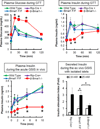Circadian control of β-cell function and stress responses
- PMID: 26332977
- PMCID: PMC4762487
- DOI: 10.1111/dom.12524
Circadian control of β-cell function and stress responses
Abstract
Circadian disruption is the bane of modern existence and its deleterious effects on health; in particular, diabetes and metabolic syndrome have been well recognized in shift workers. Recent human studies strongly implicate a 'dose-dependent' relationship between circadian disruption and diabetes. Genetic and environmental disruption of the circadian clock in rodents leads to diabetes secondary to β-cell failure. Deletion of Bmal1, a non-redundant core clock gene, leads to defects in β-cell stimulus-secretion coupling, decreased glucose-stimulated ATP production, uncoupling of OXPHOS and impaired glucose-stimulated insulin secretion. Both genetic and environmental circadian disruptions are sufficient to induce oxidative stress and this is mediated by a disruption of the direct transcriptional control of the core molecular clock and Bmal1 on Nrf2, the master antioxidant transcription factor in the β-cell. In addition, circadian disruption also leads to a dysregulation of the unfolded protein response and leads to endoplasmic reticulum stress in β-cells. Both the oxidative and endoplasmic reticulum (ER) stress contribute to an impairment of mitochondrial function and β-cell failure. Understanding the basis of the circadian control of these adaptive stress responses offers hope to target them for pharmacological modulation to prevent and mitigate the deleterious metabolic consequences of circadian disruption.
Keywords: Bmal1; ER stress; OXPHOS; Rev-erb; UPR; circadian; clock; diabetes; insulin; islet; mitochondria; oxidative stress; shift work; β-cell.
© 2015 John Wiley & Sons Ltd.
Conflict of interest statement
There are no potential conflicts of interest.
Figures
References
-
- Schibler U. The 2008 Pittendrigh/Aschoff lecture: peripheral phase coordination in the mammalian circadian timing system. J Biol Rhythms. 2009;24:3–15. - PubMed
-
- De Bacquer D, Van Risseghem M, Clays E, Kittel F, De Backer G, Braeckman L. Rotating shift work and the metabolic syndrome: a prospective study. Int J Epidemiol. 2009;38:848–854. - PubMed
-
- Karlsson BH, Knutsson AK, Lindahl BO, Alfredsson LS. Metabolic disturbances in male workers with rotating three-shift work. Results of the WOLF study. Int Arch Occup Environ Health. 2003;76:424–430. - PubMed
-
- Kroenke CH, Spiegelman D, Manson J, Schernhammer ES, Colditz GA, Kawachi I. Work characteristics and incidence of type 2 diabetes in women. Am J Epidemiol. 2007;165:175–183. - PubMed
Publication types
MeSH terms
Substances
Grants and funding
LinkOut - more resources
Full Text Sources
Other Literature Sources








